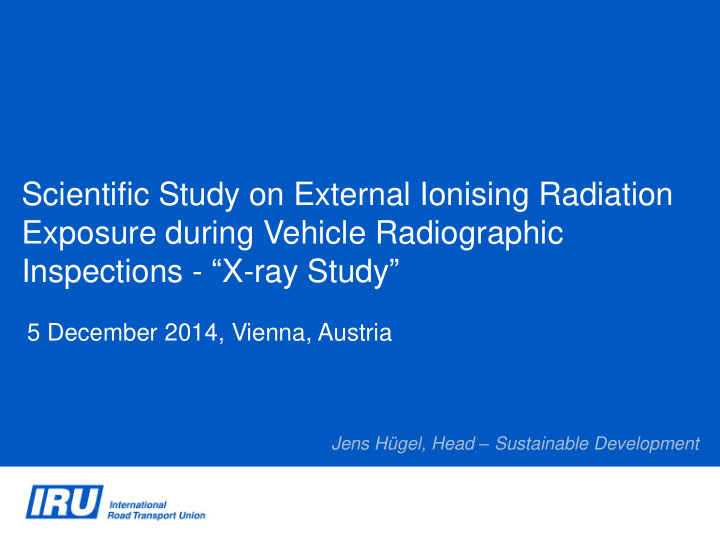



Scientific Study on External Ionising Radiation Exposure during Vehicle Radiographic Inspections - “ X-ray Study ” 5 December 2014, Vienna, Austria Jens Hügel, Head – Sustainable Development
This is the IRU 2
Evolution of IRU Membership 2014: 170 Members in 75 2014: 170 Members in 75 countries countries 1948: eight founder countries …and CRIPA: 27 Members + FESARTA in 38 countries 3
Security demands lead to increase in vehicle scanning Is there a health and safety risk for drivers? 4
Scientific Study Study by the Institute for Medical Research and Occupational Health Zagreb, Croatia – Recommended by the ILO 5
There are 2 types of scanners used at borders Silhouette Scanner Driver sits inside the vehicle Driver drives the vehicle through the scanner 6
There are 2 types of scanners used at borders LINAC Scanner Driver is not in the vehicle LINAC scanner moves along the stationary vehicle 7
Study Methodology Background radiation was measured and equipment calibrated Phantom driver control measurements Drivers carried personal dosimeters Dosimeters were placed in the cabin 8
Study Methodology On site scanning and safety procedures were observed and compared with accepted international standards Customs officers, x-ray scanning operators, inspection staff and drivers were interviewed at every border crossing visited 9
Study Results Customs keep history track of every truck - company - driver scanned (blacklist?) 10
Study Results Scanning stationary vehicles takes considerable time Clear information on the scanning process is missing Border authorities were sometimes not acquainted with radiation protection standards 11
Study Results There is an occupational health and safety risks for drivers if safety procedures are not followed No residual radiation occurs in the vehicle 12
Study Results Internationally recognised radiation protection standards are not always followed 13
4 Main Recommendations 1. Install appropriate information panels everywhere x-ray scanning is performed 2. Develop x-ray scanning certificates to avoid repetitive scanning and to accelerate the x-ray scanning process 3. Implement internationally recognised x-ray scanning procedures 4. Improve education of drivers, Customs officers and x-ray scanning operators on the functioning and risks of x-ray scanning 14
Recommend
More recommend